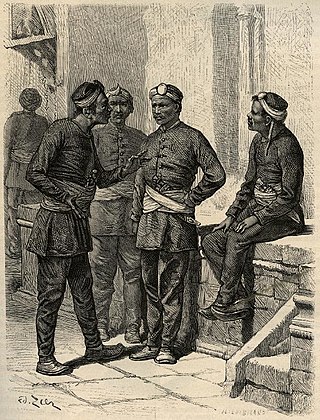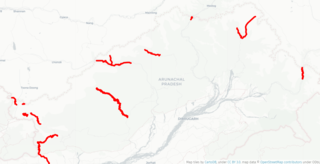
Sikkim is a state in northeastern India. It borders the Tibet Autonomous Region of China in the north and northeast, Bhutan in the east, Koshi Province of Nepal in the west, and West Bengal in the south. Sikkim is also close to the Siliguri Corridor, which borders Bangladesh. Sikkim is the least populous and second-smallest among the Indian states. Situated in the Eastern Himalaya, Sikkim is notable for its biodiversity, including alpine and subtropical climates, as well as being a host to Kangchenjunga, the highest peak in India and third-highest on Earth. Sikkim's capital and largest city is Gangtok. Almost 35% of the state is covered by Khangchendzonga National Park – a UNESCO World Heritage Site.

The Gurkhas or Gorkhas, with the endonym Gorkhali, are soldiers native to the Indian subcontinent, chiefly residing within Nepal and some parts of North India.

The Indo-Tibetan Border Police (ITBP) is a central armed police force in India under the Ministry of Home Affairs. It is responsible for guarding India’s border with Tibet. It was formed aftermath of the Sino-Indian War of 1962.

The history of Sikkim begins with the indigenous Lepcha's contact with early Tibetan settlers. Historically, Sikkim was a sovereign Monarchical State in the eastern Himalayas. Later a protectorate of India followed by a merger with India and official recognition as a state of India. Lepchas were the main inhabitants as well as the Rulers of the land up to 1641. Lepchas are generally considered to be the first people, Indigenous to Sikkim also includes Darjeeling.

The 11 Gorkha Rifles is a Gorkha regiment of the Indian Army that was re-raised after independence. The regiment consists of primarily the Kirant Tribes Rai, Limbu, Yakkha, Sunuwar of Eastern Nepal, Darjeeling, Kalimpong, Dooars of West Bengal, Sikkim and other parts of Northeast India. Though it is considered to be the youngest of the Gorkha regiments its lineage is as long as those of the 7th Gurkha Rifles and 10th Gurkha Rifles.

The Kumaon Regiment is one of the oldest infantry regiments of the Indian Army. The regiment traces its origins to the 18th century and has fought in every major campaign of the British Indian Army and the Indian Army, including the two world wars, and is one of the highest decorated regiments of the Indian Army.

The Special Frontier Force (SFF) is a paramilitary Indian special forces unit composed primarily of Tibetan refugees and Gurkhas in India. It was established after the Sino-Indian War of 1962 to primarily conduct covert operations behind the Chinese lines in case of another war with China. Later it increased in size and scope of operations.

The Assam Regiment is an infantry regiment of the Indian Army. The regiment consists of 25 battalions: 15 regular battalions, 3 Rashtriya Rifles battalions, 5 Territorial Army battalions & 2 Arunachal Scouts battalions. It recruits exclusively from all the eight Northeastern states of India.

The Sino–Indian border dispute is an ongoing territorial dispute over the sovereignty of two relatively large, and several smaller, separated pieces of territory between China and India. The territorial disputes between the two countries result from the historical consequences of colonialism in Asia and the lack of clear historical boundary demarcations.

Sashastra Seema Bal is a central armed police force in India under the Ministry of Home Affairs. It is responsible for guarding India’s borders with Nepal and Bhutan.
The Arunachal Scouts is a mountain infantry regiment of the Indian army based in Arunachal Pradesh. This unit specializes in cold-weather warfare and mountain warfare, counterinsurgency, jungle warfare, long-range penetration, maneuver warfare, raiding with small unit tactics, and reconnaissance in difficult to reach and dangerous terrain. The regiment was established with the purpose of counterinsurgency and defending the Indian-Chinese border in Arunachal Pradesh. A large proportion of the Arunachal Scouts are local to the region in which they work. Previously Part of the Indian Army’s Assam Regiment, the Arunachal Scouts consist of two battalions, the first raised in 2010 and second in 2012.

The Ladakh Scouts is a mountain infantry regiment of the Indian Army, nicknamed as the "Snow Warriors" or "Snow Leopards". The regiment specializes in cold-weather warfare and mountain warfare, long-range penetration, maneuver warfare, raiding with small unit tactics, and reconnaissance in difficult to reach and dangerous terrain. Its primary role is to guard India's borders in the high altitudes of the Union Territory of Ladakh.
Officers and soldiers of the Indian Army wear cap badges on their beret or peaked caps. The design is based on the regimental insignia or coat of arms.

India–China Border Roads is a Government of India project for developing infrastructure along the Sino-Indian border by constructing strategic roads, including bridges and tunnels. The ICBR project is largely in response to Chinese infrastructure development along the borderlands with India. Several entities are responsible for constructing ICBR, including Border Roads Organisation (BRO) which handles the bulk of the ICBR road construction work, National Highways Authority of India (NHAI), National Highways and Infrastructure Development Corporation Limited (NHIDCL), Ministry of Development of North Eastern Region (MoDNER), Central Public Works Department (CPWD), public works departments of respective states and others. At least 67 per cent of the road network assigned to BRO falls under ICBR.
The Five Fingers of Tibet was a Chinese territorial claim to the Himalayan region bordering India attributed to Mao Zedong. It considers Tibet to be China's right hand palm, with five fingers on its periphery: Ladakh, Nepal, Sikkim, Bhutan, and North-East Frontier Agency that are considered China's responsibility to "liberate". The policy however has never been discussed in official Chinese public statements and is now dormant, but concerns have often been raised over its possible continued existence or revival.
Scouts in the British Empire meant a locally raised standing paramilitary, not part of the British Army or British Indian Army, under the command of a local Chief or commissioner, but with attached British officers. Scouts were internal and border security units composed of locals, officered by British officers.
Indian order of battle during the 2020–2021 China–India skirmishes:

The infantry of the Indian army is the largest arm of the Indian army. It consists of personnel, who historically have engaged in ground combat on foot. It presently also consists of mechanised and airborne infantry.














